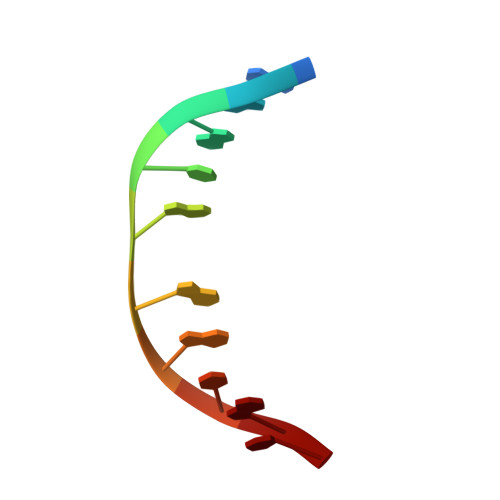MISPAIRING OF THE 8,9-DIHYDRO-8-(N7-GUANYL)-9-HYDROXY-AFLATOXIN B1 ADDUCT WITH DEOXYADENOSINE RESULTS IN EXTRUSION OF THE MISMATCHED DA TOWARD THE MAJOR GROOVE
Giri, I., Johnston, D.S., Stone, M.P.(2002) Biochemistry 41: 5462-5472
- PubMed: 11969407
- DOI: https://doi.org/10.1021/bi012116t
- Primary Citation of Related Structures:
1MK6 - PubMed Abstract:
The G --> T transversion is the dominant mutation induced by the cationic trans-8,9-dihydro-8-(N7-guanyl)-9-hydroxy-aflatoxin B(1) adduct. The structure of d(ACATC(AFB)GATCT).d(AGATAGATGT), in which the cationic adduct was mismatched with deoxyadenosine, was refined using molecular dynamics calculations restrained by NOE data and dihedral restraints obtained from NMR spectroscopy. Restrained molecular dynamics calculations refined structures with pairwise rmsd <1 A and a sixth root R1x factor between the refined structure and NOE data of 10.5 x 10-2. The mismatched duplex existed in a single conformation at neutral pH. The aflatoxin moiety intercalated above the 5' face of the modified (AFB)G. The mismatched dA was in the anti conformation about the glycosyl bond. It extruded toward the major groove and did not participate in hydrogen bonding with (AFB)G. The structure was compared with that of d(ACATCGATCT).d(AGATAGATGT) containing the corresponding unmodified G.A mismatch and with d(ACATC(AFB)GATCT).d(AGATCGATGT) containing the aflatoxin lesion in the correctly paired (AFB)G.C context. The correctly paired oligodeoxynucleotide exhibited Watson-Crick-type geometry at the (AFB)G.C pair. It melted at higher temperature than the mismatched (AFB)G.A duplex. The unmodified mismatched G.A duplex exhibited spectral line broadening at neutral pH, suggesting a mixture of conformations. It exhibited a lower melting temperature than did the mismatched (AFB)G.A duplex. These differences correlated with replication bypass experiments performed in vitro utilizing DNA polymerase I exo- [Johnston, D. S., and Stone, M. P. (2000) Chem. Res. Toxicol. 13, 1158-1164]. Those experiments showed that correct insertion of dC opposite (AFB)G blocked replication by the enzyme, whereas incorrect insertion of dA opposite (AFB)G allowed full-length replication of the adducted template strand.
- Department of Chemistry and Center in Molecular Toxicology, Vanderbilt University, Nashville, Tennessee 37235, USA.
Organizational Affiliation:


















